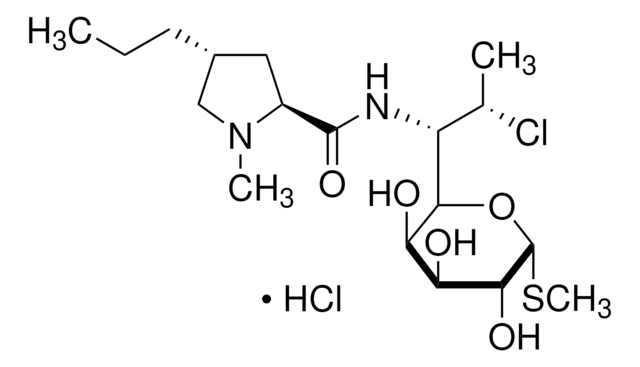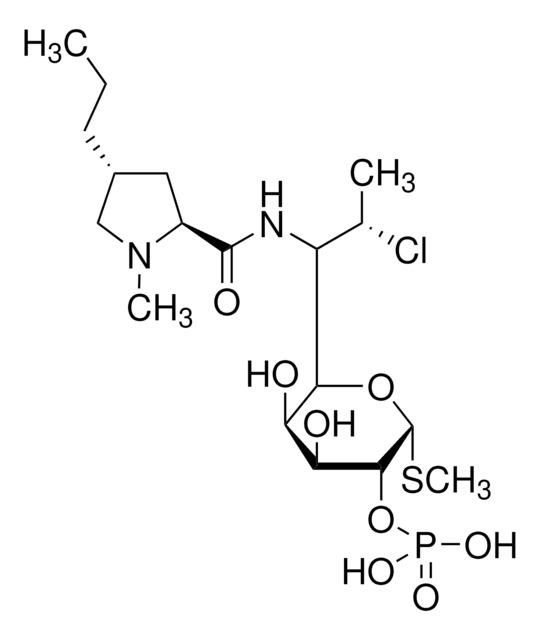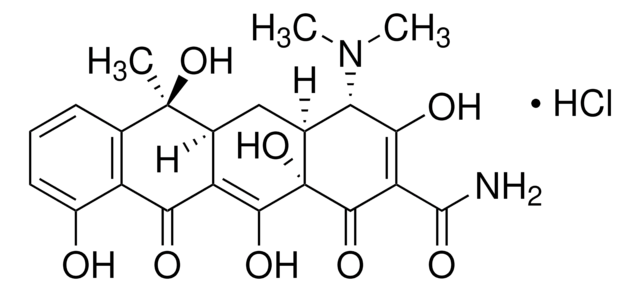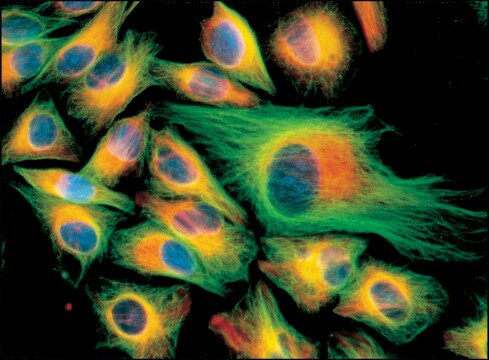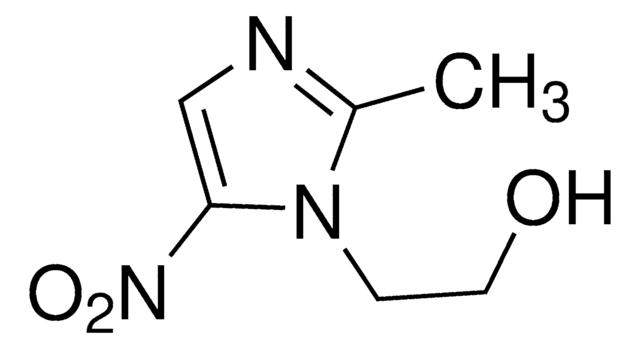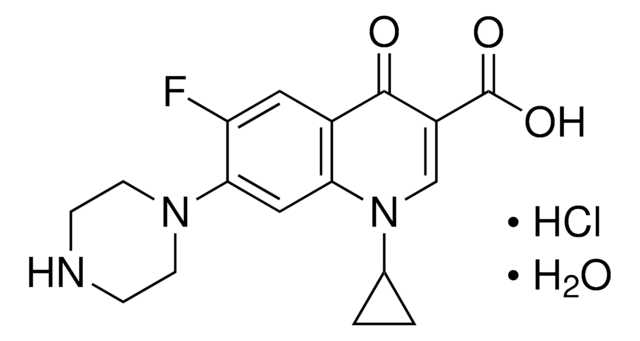추천 제품
Quality Level
양식
powder or crystals
불순물
≤13%
solubility
H2O: 50 mg/mL
항생제 활성 스펙트럼
Gram-negative bacteria
Gram-positive bacteria
동작 모드
protein synthesis | interferes
저장 온도
2-8°C
SMILES string
Cl.CCC[C@@H]1C[C@H](N(C)C1)C(=O)N[C@H]([C@H](C)Cl)C2O[C@H](SC)[C@H](O)[C@@H](O)[C@H]2O
InChI
1S/C18H33ClN2O5S.ClH/c1-5-6-10-7-11(21(3)8-10)17(25)20-12(9(2)19)16-14(23)13(22)15(24)18(26-16)27-4;/h9-16,18,22-24H,5-8H2,1-4H3,(H,20,25);1H/t9-,10+,11-,12+,13-,14+,15+,16+,18+;/m0./s1
InChI key
AUODDLQVRAJAJM-XJQDNNTCSA-N
유사한 제품을 찾으십니까? 방문 제품 비교 안내
일반 설명
Chemical structure: macrolide
애플리케이션
Clindamycin is used to study bacterial infections, such as group B streptococcal disease, bacterial resistance and plasma protein binding.
Used to study bacterial protein synthesis.
생화학적/생리학적 작용
Clindamycin hydrochloride is highly effective against anaerobic species.
Clindamycin is a semi-synthetic, lincosamide antibiotic that is prepared from lincomycin. It inhibits bacterial protein synthesis by hydrogen bond interactions with the 23S rRNA component of the 50S ribosomal subunit thus inducing dissociation of the peptidyl-t-RNA complex. It has antibacterial activity against Gram-positive cocci and antiprotozoal activity against Taxoplasma.
기타 정보
Antibacterial and antiprotozoal antibiotic of the lincosamide class.
Keep container tightly closed in a dry and well-ventilated place.
신호어
Warning
유해 및 위험 성명서
Hazard Classifications
Eye Irrit. 2 - Lact. - Skin Sens. 1
Storage Class Code
11 - Combustible Solids
WGK
WGK 2
Flash Point (°F)
Not applicable
Flash Point (°C)
Not applicable
이미 열람한 고객
Sonja Löfmark et al.
The Journal of antimicrobial chemotherapy, 58(6), 1160-1167 (2006-10-19)
The aim was to study the long-term consequences of 1 week clindamycin administration regarding selection and persistence of resistance, resistance determinants and diversity of the Bacteroides spp. in the intestinal microflora. A total of 1306 Bacteroides isolates were collected from
Anouk E Muller et al.
Antimicrobial agents and chemotherapy, 54(5), 2175-2181 (2010-02-24)
The study presented here was performed to determine the pharmacokinetics of intravenously administered clindamycin in pregnant women. Seven pregnant women treated with clindamycin were recruited. Maternal blood and arterial and venous umbilical cord blood samples were obtained. Maternal clindamycin concentrations
A Burian et al.
The Journal of antimicrobial chemotherapy, 66(1), 134-137 (2010-11-04)
although plasma protein binding (PPB) is accepted to be an essential factor in reducing antimicrobial activity, little is known about the underlying mechanisms. One possibility includes impaired penetration of an antimicrobial into bacterial cells in the presence of PPB. As
Michael C Jewett et al.
Molecular systems biology, 9, 678-678 (2013-06-27)
Purely in vitro ribosome synthesis could provide a critical step towards unraveling the systems biology of ribosome biogenesis, constructing minimal cells from defined components, and engineering ribosomes with new functions. Here, as an initial step towards this goal, we report
J Spízek et al.
Applied microbiology and biotechnology, 64(4), 455-464 (2004-02-06)
Lincomycin and clindamycin are lincosamide antibiotics used in clinical practice. Both antibiotics are bacteriostatic and inhibit protein synthesis in sensitive bacteria. They may even be bactericidal at the higher concentrations that can be reached in vivo. Clindamycin is usually more
자사의 과학자팀은 생명 과학, 재료 과학, 화학 합성, 크로마토그래피, 분석 및 기타 많은 영역을 포함한 모든 과학 분야에 경험이 있습니다..
고객지원팀으로 연락바랍니다.